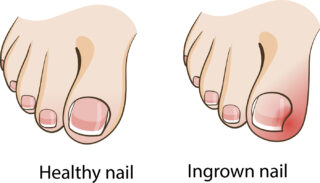
Largo Foot and Ankle Health Center
1450 Mercantile Lane
Suite 151
Upper Marlboro, MD 20774

More Podiatry Foot Care Articles
Ingrown Toenails

Ingrown nails (onychocryptosis) are the most common nail impairment. An ingrown toenail occurs when the edge or edges of the nail grows down and into the skin of the toe. Usually, toenails grow straight out. Sometimes, however, nail corners or sides dig painfully into the soft tissue of nail grooves, often leading to irritation, redness, and swelling. The big toe is the most common location for this condition, but other toes can also become affected. Some people are more prone to ingrown toenails.
Ingrown toenails may be caused by the following:
- Improperly trimmed nails
- Heredity
- Shoe pressure; crowding of toes
- Repeated trauma to the feet from normal activities
The following symptoms may be present with ingrown toenails
- Pain
- Redness and swelling
- Drainage
- Odor
- Prominent skin tissue (proud flesh)
If you suspect an infection due to an ingrown toenail, immerse the foot in a warm saltwater soak, or a basin of soapy water, then apply an antiseptic and bandage the area.
People with diabetes, peripheral vascular disease, or other circulatory disorders must avoid any form of self-treatment and seek podiatric medical care as soon as possible.
Other “do-it-yourself” treatments, including any attempt to remove any part of an infected nail or the use of over-the-counter medications, should be avoided. Nail problems should be evaluated and treated by your podiatrist, who can diagnose the ailment, and then prescribe medication or another appropriate treatment.
When To Visit a Podiatrist
You should see a podiatrist immediately if any drainage or excessive redness is present around the toenail. Also, if a short trial of home treatment has not resulted in improvement of the condition, see your podiatrist. If you have diabetes or poor circulation, you should seek immediate treatment at the first signs of an ingrown toenail, as it can lead to more severe complications.
Diagnosis and Treatment
A podiatrist will remove the ingrown portion of the nail and may prescribe a topical or oral medication to treat the infection. If ingrown nails are a chronic problem, your podiatrist can perform a procedure to permanently prevent ingrown nails. The corner of the nail that ingrows, along with the matrix or root of that piece of nail, are removed by use of a chemical, a laser, or other methods.

















